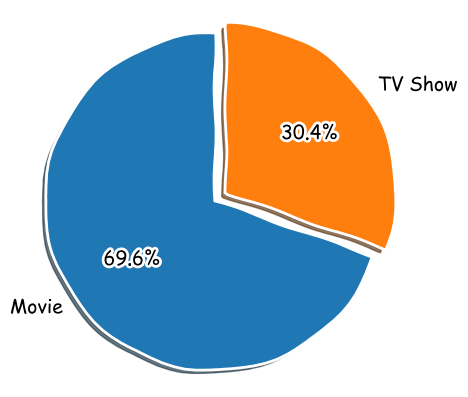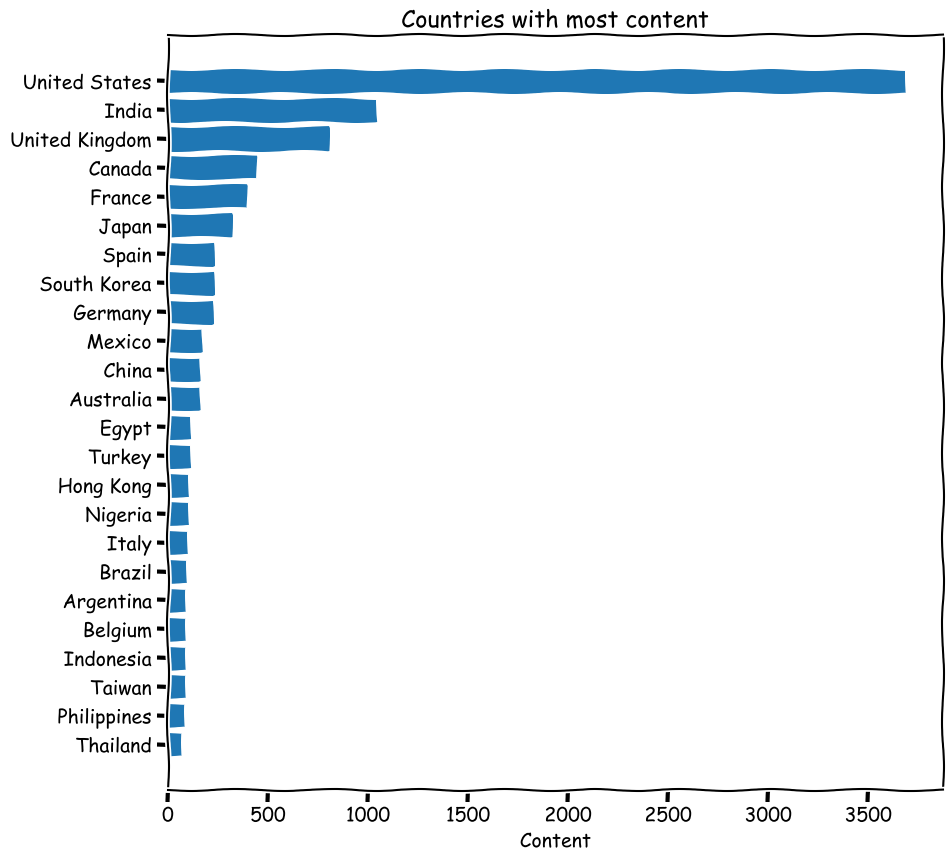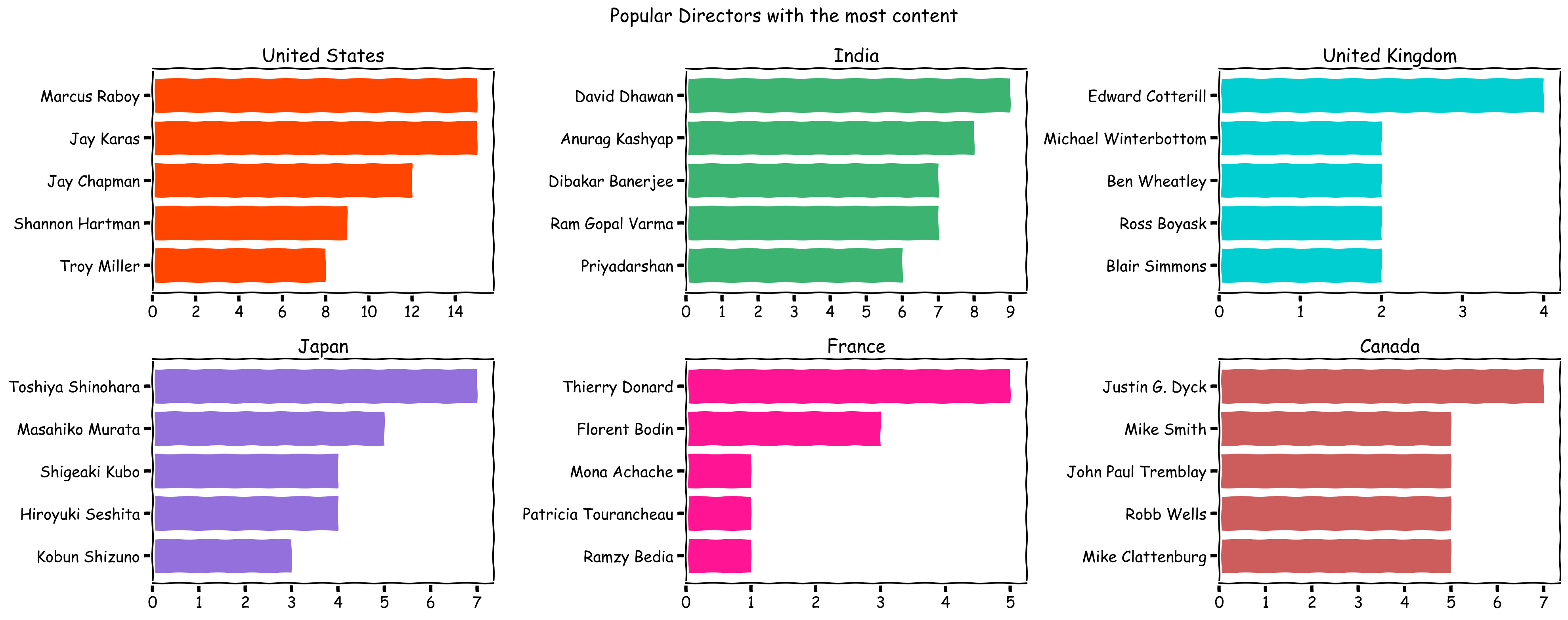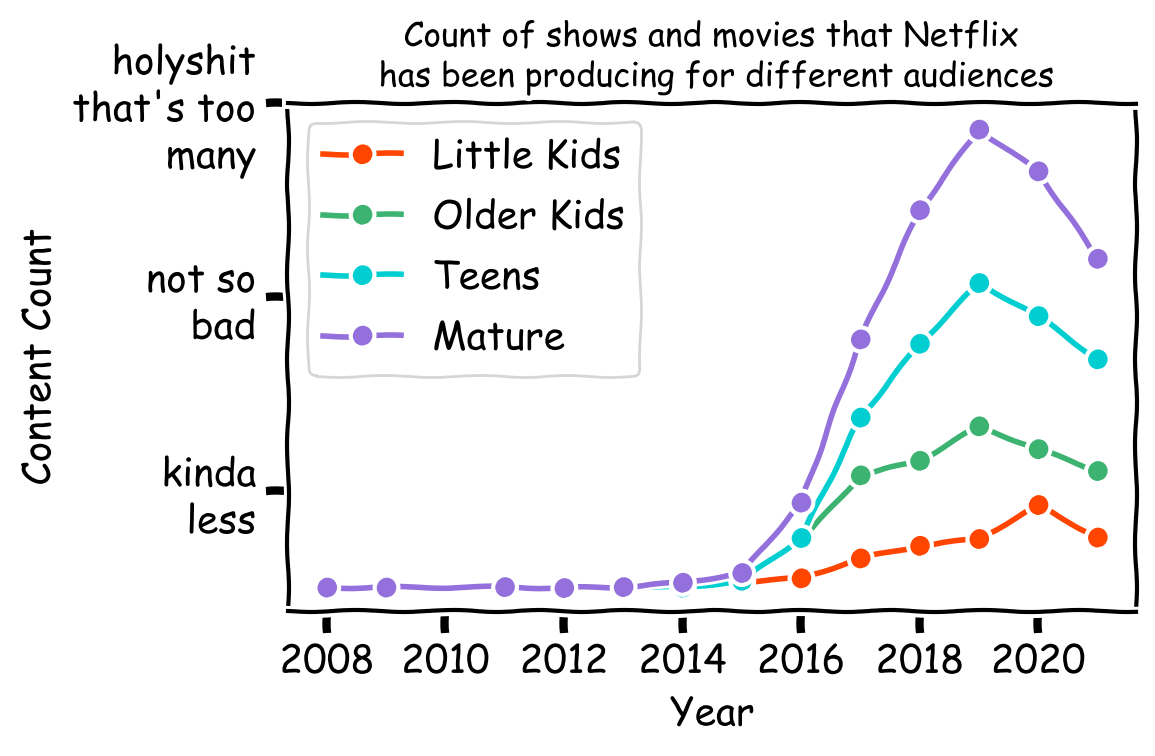代码下载
https://github.com/hidadeng/DaDengAndHisPython/tree/master/20211031使用matplotlib绘制卡通化图表
数据可视化是讲故事的好方法,从中可以轻松地吸收信息并识别数据中的模式。我们的一位学生决定使用 Matplotlib 在 Python 中创建数据可视化,以了解 Netflix 上可用的不同类型的内容。本文将重点介绍使用 Matplotlib 以一种有趣的方式进行数据可视化。
在 Netflix 上看完精彩的节目或电影后,您有没有想过 Netflix 为您提供了如此多的惊人内容?当然,我并不孤单,不是吗?一个想法会导致另一个想法,在不知不觉中,您已经下定决心进行探索性数据分析,以了解更多关于最受欢迎的演员是谁以及哪个国家/地区更喜欢哪种类型的信息。
使用 Python 制作常规的条形图和饼图,虽然它们在传达结果方面做得很好,但我想为这个项目添加一些有趣的元素。
我最近了解到你可以在 Python 最流行的数据可视化库 Matplotlib 中创建类似 xkcd 的绘图,并决定我应该在这个项目中整理我所有的 Matplotlib 可视化,只是为了让事情变得更有趣。
一起来看看数据怎么说吧!
导入数据
7787部电影/TV节目的信息
import pandas as pd
df = pd.read_csv("netflix_titles.csv")
df.head()

Netflix历年发展里程碑
描述一下 Netflix 多年来演变的时间表。
import matplotlib.pyplot as plt
import numpy as np
plt.rcParams['figure.dpi'] = 200
# these go on the numbers below
tl_dates = [
"1997\nFounded",
"1998\nMail Service",
"2003\nGoes Public",
"2007\nStreaming service",
"2016\nGoes Global",
"2021\nNetflix & Chill"
]
tl_x = [1, 2, 4, 5.3, 8, 9]
# the numbers go on these
tl_sub_x = [1.5,3,5,6.5,7]
tl_sub_times = [
"1998","2000","2006","2010","2012"
]
tl_text = [
"Netflix.com launched",
"Starts\nPersonal\nRecommendations","Billionth DVD Delivery","Canadian\nLaunch","UK Launch"]
with plt.xkcd():
# Set figure & Axes
fig, ax = plt.subplots(figsize=(15, 4), constrained_layout=True)
ax.set_ylim(-2, 1.75)
ax.set_xlim(0, 10)
# Timeline : line
ax.axhline(0, xmin=0.1, xmax=0.9, c='deeppink', zorder=1)
# Timeline : Date Points
ax.scatter(tl_x, np.zeros(len(tl_x)), s=120, c='palevioletred', zorder=2)
ax.scatter(tl_x, np.zeros(len(tl_x)), s=30, c='darkmagenta', zorder=3)
# Timeline : Time Points
ax.scatter(tl_sub_x, np.zeros(len(tl_sub_x)), s=50, c='darkmagenta',zorder=4)
# Date Text
for x, date in zip(tl_x, tl_dates):
ax.text(x, -0.55, date, ha='center',
fontfamily='serif', fontweight='bold',
color='royalblue',fontsize=12)
# Stemplot : vertical line
levels = np.zeros(len(tl_sub_x))
levels[::2] = 0.3
levels[1::2] = -0.3
markerline, stemline, baseline = ax.stem(tl_sub_x, levels, use_line_collection=True)
plt.setp(baseline, zorder=0)
plt.setp(markerline, marker=',', color='darkmagenta')
plt.setp(stemline, color='darkmagenta')
# Text
for idx, x, time, txt in zip(range(1, len(tl_sub_x)+1), tl_sub_x, tl_sub_times, tl_text):
ax.text(x, 1.3*(idx%2)-0.5, time, ha='center',
fontfamily='serif', fontweight='bold',
color='royalblue', fontsize=11)
ax.text(x, 1.3*(idx%2)-0.6, txt, va='top', ha='center',
fontfamily='serif',color='royalblue')
# Spine
for spine in ["left", "top", "right", "bottom"]:
ax.spines[spine].set_visible(False)
# Ticks
ax.set_xticks([])
ax.set_yticks([])
# Title
ax.set_title("Netflix through the years", fontweight="bold", fontfamily='serif', fontsize=16, color='royalblue')
ax.text(2.4,1.57,"From DVD rentals to a global audience of over 150m people - is it time for Netflix to Chill?", fontfamily='serif', fontsize=12, color='mediumblue')
plt.show()

电影 vs 电视综艺
接下来,我决定看一下电影与电视节目的比例。
col = "type"
grouped = df[col].value_counts().reset_index()
grouped = grouped.rename(columns = {col : "count", "index" : col})
with plt.xkcd():
explode = (0, 0.1) # only "explode" the 2nd slice (i.e. 'TV Show')
fig1, ax1 = plt.subplots(figsize=(5, 5), dpi=100)
ax1.pie(grouped["count"], explode=explode, labels=grouped["type"], autopct='%1.1f%%',
shadow=True, startangle=90)
ax1.axis('equal') # Equal aspect ratio ensures that pie is drawn as a circle.
plt.show()

内容最多的国家
from collections import Counter
col = "country"
categories = ", ".join(df[col].fillna("")).split(", ")
counter_list = Counter(categories).most_common(25)
counter_list = [_ for _ in counter_list if _[0] != ""]
labels = [_[0] for _ in counter_list]
values = [_[1] for _ in counter_list]
with plt.xkcd():
fig, ax = plt.subplots(figsize=(10, 10), dpi=100)
y_pos = np.arange(len(labels))
ax.barh(y_pos, values, align='center')
ax.set_yticks(y_pos)
ax.set_yticklabels(labels)
ax.invert_yaxis() # labels read top-to-bottom
ax.set_xlabel('Content')
ax.set_title('Countries with most content')
plt.show()

最流行的导演
from collections import Counter
from matplotlib.pyplot import figure
import math
colours = ["orangered", "mediumseagreen", "darkturquoise", "mediumpurple", "deeppink", "indianred"]
countries_list = ["United States", "India", "United Kingdom", "Japan", "France", "Canada"]
col = "director"
with plt.xkcd():
figure(num=None, figsize=(20, 8))
x=1
for country in countries_list:
country_df = df[df["country"]==country]
categories = ", ".join(country_df[col].fillna("")).split(", ")
counter_list = Counter(categories).most_common(6)
counter_list = [_ for _ in counter_list if _[0] != ""]
labels = [_[0] for _ in counter_list][::-1]
values = [_[1] for _ in counter_list][::-1]
if max(values)<10:
values_int = range(0, math.ceil(max(values))+1)
else:
values_int = range(0, math.ceil(max(values))+1, 2)
plt.subplot(2, 3, x)
plt.barh(labels,values, color = colours[x-1])
plt.xticks(values_int)
plt.title(country)
x+=1
plt.suptitle('Popular Directors with the most content')
plt.tight_layout()
plt.show()

Netflix 专注于什么样的内容?
我还想浏览评级栏并比较 Netflix 为儿童、青少年和成人制作的内容量——以及这些年来他们的重点是否从一个群体转移到另一个群体。
为此,我首先查看了 DataFrame 中的独特评级:
df["date_added"] = pd.to_datetime(df['date_added'])
df['year_added'] = df['date_added'].dt.year.astype('Int64')
ratings_list = ['TV-MA', 'R', 'PG-13', 'TV-14', 'TV-PG', 'TV-G', 'TV-Y', 'TV-Y7', 'PG', 'G', 'NC-17', 'TV-Y7-FV']
ratings_group_list = ['Little Kids', 'Older Kids', 'Teens', 'Mature']
ratings_dict={
'TV-G': 'Little Kids',
'TV-Y': 'Little Kids',
'G': 'Little Kids',
'TV-PG': 'Older Kids',
'TV-Y7': 'Older Kids',
'PG': 'Older Kids',
'TV-Y7-FV': 'Older Kids',
'PG-13': 'Teens',
'TV-14': 'Teens',
'TV-MA': 'Mature',
'R': 'Mature',
'NC-17': 'Mature'
}
for rating_val, rating_group in ratings_dict.items():
df.loc[df.rating == rating_val, "rating"] = rating_group
df['rating_val']=1
x=0
labels=['kinda\nless', 'not so\nbad', 'holyshit\nthat\'s too\nmany']
with plt.xkcd():
for r in ratings_group_list:
grouped = df[df['rating']==r]
year_df = grouped.groupby(['year_added']).sum()
year_df.reset_index(level=0, inplace=True)
plt.plot(year_df['year_added'], year_df['rating_val'], color=colours[x], marker='o')
values_int = range(2008, math.ceil(max(year_df['year_added']))+1, 2)
plt.yticks([200, 600, 1000], labels)
plt.xticks(values_int)
plt.title('Count of shows and movies that Netflix\n has been producing for different audiences', fontsize=12)
plt.xlabel('Year', fontsize=14)
plt.ylabel('Content Count', fontsize=14)
x+=1
plt.legend(ratings_group_list)
plt.tight_layout()
plt.show()

